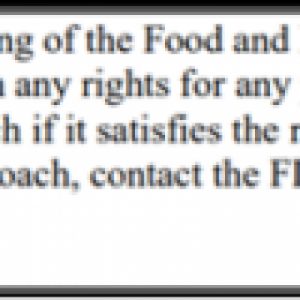
Drug pricing and payment reform is a three-legged stool drawing support from the Administration, the House, and the Senate. Yesterday our post focused on the Administration’s priorities and initiatives, as described in HHS’s recent Comprehensive Plan for Addressing High Drug Prices. Today we focus on the House, which, on the same day as the HHS report, released text of its budget reconciliation bill, entitled the Build Back Better Act (BBB Act), which is currently undergoing committee markup. This bill, which addresses numerous areas of the economy, public health, and government regulation, includes Subtitle E, Drug Pricing. Subtitle E is a slightly modified version of H.R. 3, the Elijah E. Cummings Lower Drug Costs Now Act introduced by Representative Pallone on April 22, which in turn was a slightly revised version of the comprehensive drug pricing bill that passed the House during the last Congress. Subtitle E draws on several ideas – most of them bipartisan – that have emerged in recent years for drug pricing and payment reform: negotiation of prices under Medicare Parts B and D with repeal of the price negotiation prohibition under Medicare Part D, benchmarking Medicare payment to foreign prices, price inflation rebates to Medicare, and restructuring of the Part D benefit. The four parts of Subtitle E are summarized in turn below.
PART 1: MAXIMUM FAIR PRICE PAYMENT LIMITATION UNDER MEDICARE PARTS B AND D AND THE COMMERCIAL INSURANCE MARKET
The most far reaching drug pricing provision of Subtitle E is an amendment to the Social Security Act to establish a Fair Price Negotiation Program applicable to Medicare Parts B and D as well as group and individual health plans in the commercial market. Beginning in 2025, payment for certain “Selected” single source drugs under Parts B and D, and under commercial plans that do not opt out of the program, would be limited to a Maximum Fair Price (MFP). The MFP would be established through negotiations between HHS and the manufacturer and would incorporate foreign pricing benchmarks, as further described below. In order to permit MFPs to be negotiated under Part D, the current prohibition on Medicare negotiating with manufacturers would be repealed.
For Selected drugs covered under Medicare Part B, the MFP would replace the average sales price (ASP) as a basis of payment (i.e., payment would generally be 106% of the MFP instead of the ASP), and for drugs covered under Part D, the MFP would replace the negotiated price (i.e., the amount Part D plans pay pharmacies for the drugs). For commercial plans, the MFP would replace the otherwise applicable payment rate. Under all of these programs, patient co-insurance would be calculated based on the MFP so that patients receive the benefit of that price. MFP pricing would also extend to the Department of Veterans Affairs, which could elect to replace the Federal Ceiling Price established under 38 U.S.C. § 8126 with a lower MFP. The MFP would be adjusted for inflation each successive year and would remain in place until a generic or biosimilar version of the Selected drug is approved.
Single source drugs would be selected, and MFPs established for them, as follows. Each year, HHS would determine the 125 single source drugs with the greatest net spending under Medicare Parts B and D, and 125 drugs with the greatest net spending in the U.S. in general (the statute does not indicate that these lists would be mutually exclusive). From this universe of single source drugs, HHS would select at least 50 drugs (or at least 25 drugs in 2025, the first year of the program) for which a negotiated price is projected to result in the greatest savings to the federal government and affected patients, taking into account the volume of utilization and the amount by which the drug’s price exceeds an Average International Market (AIM) price. The AIM price is the volume-weighted average price of the drug in Australia, Canada, France, Germany, Japan, and the U.K. A drug selected in one year could not count toward the minimum of 50 selected the following year, so that the cumulative number of Selected drugs would increase substantially each year.
HHS would publish the list of Selected drugs in the Federal Register by April 1 of the second year preceding the applicable pricing year. The manufacturer of a Selected drug would then be required to enter into MFP negotiations with HHS. The latter would take into consideration financial information such as research and development (R&D) costs, market data, costs of production, prior federal R&D support, and sales data; effectiveness compared with other therapeutic alternatives; whether the drug represents a therapeutic advance; and foreign sales information. The manufacturer would be required to submit cost, sales, R&D, and other data to HHS. The agreed upon MFP could not exceed 120% of the AIM price, or for drugs for which an AIM price is unavailable, 85% of the Medicaid Rebate Average Manufacturer Price (AMP). If a manufacturer offered a price equal to the lowest average price in any of the countries listed above (or, in the absence of an available AIM price, 80% of AMP), that price would automatically be accepted as the MFP. The final MFPs would be published by April 1 of the year before the applicable pricing year.
After an MFP was agreed to for a Selected drug, HHS could decide to renegotiate the MFP if there were changes in the AIM price or in the negotiation factors referred to above. A manufacturer that refused to negotiate, delayed negotiations, or delayed submitting required information would be subject to an excise tax increasing with the time of noncompliance and also with the price of the drug. A manufacturer that failed to provide access to the MFP would be subject to a civil monetary penalty of ten times the excessive price charged.
PART 2: INFLATION REBATES UNDER MEDICARE PARTS B AND D
The second drug pricing provision in Subtitle E would impose rebates on Medicare Part B and Part D drugs whose prices increase greater than inflation, similar to the additional rebate currently required under the Medicaid Drug Rebate Program.
The Part B rebate would be payable for single source drugs and biologicals (including biosimilars). For drugs approved on or before July 1, 2015, the inflation rebates would be payable beginning 3Q 2023, and for those approved after that date, rebates would be payable beginning with the later of 3Q 2023 or the sixth full calendar quarter after launch. The amount of the rebate per unit would be the amount by which the current quarter Part B ASP-based payment amount exceeds the payment amount for a baseline quarter, adjusted for inflation. For drugs approved before July 1, 2015, the baseline quarter is 1Q 2016, and for drugs approved after that date, the baseline quarter is the third full quarter after launch. Thought the Part B rebates would not initially apply to multiple source drugs, HHS would have the authority to extend the rebates to multiple source drugs pursuant to a rulemaking.
Unlike the Medicare Part B rebates, the Part D rebates would not be not limited to single source drugs. The Part D rebates would be paid each year instead of quarterly, beginning with rebates for 2023. Since manufacturers do not calculate or submit any prices under Part D, the statute borrows the AMP submitted under the Medicaid Drug Rebate Program to develop an “Annual Manufacturer Price” for both the rebate calculation year and a baseline year. The Annual Manufacturer Price is essentially an average of the quarterly AMPs reported to CMS for the four quarters of the year, weighted by units sold during the quarter. The unit rebate amount would be the amount by which the Annual Manufacturer Price for the rebate year exceeds that for the baseline year, adjusted for inflation. For drugs approved on or before January 1, 2016, the baseline year would be 2016, and for those approved after that date, it would be the first calendar year following launch.
Excluded from both the Part B and the Part D rebates would be drugs in shortage, drugs subject to an MFP (see Part 1, above), and drugs for which the average total annual allowed charges (Part B) or cost (Part D) for an individual are less than $100 (adjusted for inflation after 2023). The Part B rebate would exclude vaccines as well. Both the Part B and Part D rebates would be excludable from ASP and Medicaid Rebate best price. The penalties for non-payment of Part B or Part D rebates would be 125% of the amount owed.
PART 3: CHANGES TO MEDICARE PART D COVERAGE GAP DISCOUNT PROGRAM AND BENEFIT STRUCTURE
Subtitle E makes substantial changes to the benefit structure and sharing of costs under Medicare Part D. Currently, a Part D enrollee passes through four phases during a plan (calendar) year (dollar thresholds are for 2021):
- Deductible ($435): enrollee pays 100% of drug cost
- Initial coverage phase (deductible to initial coverage limit ($4,130 in total drug costs)): plan pays 75%, enrollee pays 25% coinsurance (or the actuarial equivalent)
- Coverage gap phase (initial coverage limit to catastrophic coverage threshold ($6,550 in patient out-of-pocket expenses)): plan pays 5%, manufacturer pays 70% through the Coverage Gap Discount Program (CGDP), enrollee pays 25% coinsurance
- Catastrophic Coverage phase: Medicare pays 80%, plan pays 15%, enrollee pays 5% coinsurance
Under Subtitle E, beginning January 1, 2024, the catastrophic coverage threshold (currently $6,550 and likely to increase in 2022 and 2023) would be substantially reduced to $2,000, and during the catastrophic coverage phase, Medicare would pay 25% instead of 80%, the plan would pay 50% instead of 15%, the enrollee would pay zero coinsurance instead of 5%, and the remaining 30% would be subsidized by manufacturers through a new Coverage Gap Discount Program (CGDP). In the coverage gap phase, the patient would continue to pay 25% coinsurance but manufacturers would subsidize 10% of the remaining cost through the new CGDP.
The new CGDP (with new agreements) would become effective on January 1, 2024, and the current CGDP would simultaneously sunset. The new CGDP program would be much like the current one, except that, consistent with the above changes to the coverage phases, the coverage gap discount would equal 10% instead of 70% of the drug cost in the coverage gap, and 30% of the drug cost instead of zero in the catastrophic coverage phase.
PART 4: OIG SAFE HARBOR AMENDMENTS RELATING TO PBM REBATES
On Nov. 30, 2020, the Trump HHS published a final rule amending the safe harbors under the Federal health care program antikickback statute as they apply to manufacturer rebates paid to Medicare Part D plans, Medicaid Managed Care plans, and their PBMs. The original January 29, 2021 effective date of that rule has been postponed several times pursuant to court orders and is likely to be again postponed until January 1, 2026 pursuant to a provision of the Senate infrastructure bill that is expected to pass the House and be signed by the President (see our post here). Subtitle E would go further and prohibit implementation of the rule altogether.
* * *
We will be following Subtitle E of the BBB Act as it works its way through the House, and also be keeping a close eye on drug pricing legislation currently being developed in the Senate for inclusion in their budget reconciliation bill. Look for future posts on this fast-evolving area.









